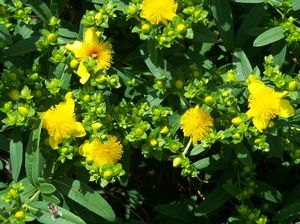View All Plants :: View All DECIDUOUS SHRUBS :: View All SUN PERENNIALS
Hypericum prolificum
St. Johnswort
Plant Type:
DECIDUOUS SHRUBSHypericum prolificum – This wonderful St. Johnswort species produces masses of small deep yellow St. Johnswort flowers for a very long period in summer. What the flowers lack in size the shrub more than makes up in number, hence “prolificum”. This shrubby St. Johnswort is a bee magnet, abuzz with many species for all the many weeks it is in bloom. The warm brown exfoliating wood which remains attractive in winter supports multitudes of 3-sided seed capsules. These supply winter interest or may be cut and used in dried arrangements. We have ours planted with Spiraea x bumalda ‘Neon Flash’ and the two make a strong summer coupling. For gardeners towards the northern end of its range spring planting is advised.
Characteristics and Attributes for Hypericum prolificum
Season of Interest (Flowering)
- Summer
Season of Interest (Foliage)
- Spring / Summer / into Autumn
Interesting Bark
- Exfoliating
Autumn Interest
- Fruit / Berries / Seed Heads
Nature Attraction
- Deer Resistant
- Honey Bees & Native Bees
Light
- Full Sun
Attributes
- Foundation
- Border
- Shrub Border
- Drought Tolerant
- Hedgerow
- Massing
- Specimen
- Wildlife Garden
Growth Rate in the Garden
- Moderately Fast
Soil
- Draining
- Adaptable
Origins
- Eastern North America
Propagated By
- Cutting Grown
Genus Overview: Hypericum
Common Name: St. Johnswort
St. Johnswort is easy, tough and dependable – they should be planted more! All have attractive sunny golden-yellow flowers, appreciate siting in full sun and planted in any decent garden soil that drains well, sandy soils are fine. They are untroubled in the north but apparently, according to Michael Dirr, they can be plagued farther south – where the cutoff is we do not know; we’re guessing the warm end of USDA zone 7. They are relatively underutilized and worthy of consideration if you live in a climate in which they will make you smile. All of the following offerings are cutting grown.


